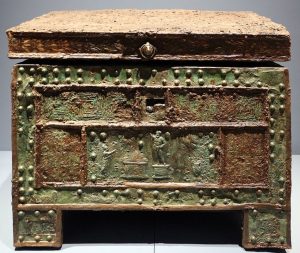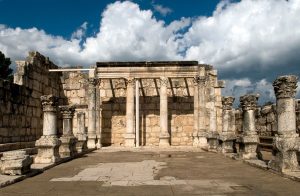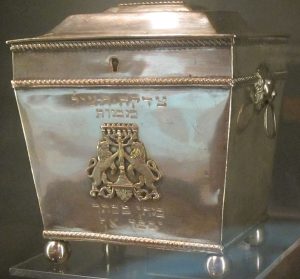Where do you keep your valuables? If your answer is a small safe at home, you are in good company. It seems that safes existed long before modern combination locks and technology:
“a certain man who kicked a safe belonging to another, sending it into the river.” (Bava Kamma 62a)
The word used here for safe is כספתא kaspeta, a word with ancient roots that is still in use today, albeit slightly modified. Kaspeta comes from the word כסף, kesef, or silver, a word that soon took on the more general meaning of money. In modern Israel your valuables (or your gun) are kept in a כספת kasefet. An even more modern iteration is a portmanteau coined by the Academy for the Hebrew Language about fifteen years ago, the כספומט, kaspomat, or ATM. This takes the old “kesef” and combines it with the new “automat” to make a money machine.
Romans had their version of a kaspeta, it was called an arca. Arca means chest (like its archaic English equivalent, ark), and it was often used to indicate a treasure chest where money was stored. There was also an Arca Publica where community funds were stored.

Arca found in Pompeii
Sailko, CC BY 3.0 <https://creativecommons.org/licenses/by/3.0>, via Wikimedia Commons
Keeping money in a box was an ancient practice. In the book of Kings the Judean ruler Yehoash is displeased that the Temple priests are not using allocated funds to repair the Temple. He decides to solve the problem by making the funds unavailable to the priests. He fashions a collection box, i.e, a box with a lock on it and a slit to put in valuables, and places it in the Temple so that people could donate and the money would not be robbed:
“And the priest Yehoiada took a chest and bored a hole in its lid. He placed it at the right side of the altar as one entered the House of God, and the priestly guards of the threshold deposited there all the money that was brought into the House of God.” (Kings II 12:10)
In 2001 an inscription surfaced on the antiquities market that seemed to echo this story, where Yehoash asks for donations for the Temple and does repairs. The jury is still out on if it is authentic or a very clever forgery.
Treasures were not always kept in boxes. As more and more ancient synagogues are unearthed in the Land of Israel, archaeologists are witnessing an intriguing phenomenon: coin stashes under the floors or in the walls of the structure. To date, more than twenty such deposits have been discovered, in synagogues that range from Ein Gedi in the Judean Desert to Dir Aziz and Um el Kanatir in the Golan. Many of the coins are of low value, small bronze discs, but there are also silver and even gold coins among these hoards. Why were they put there and what can we learn from them?
Any budding archaeologist will tell you that a coin discovery really is a treasure, not for its monetary value but because of the information it provides. Coins have names, dates and pictures that allow us to date a site. If only for that reason, these synagogue treasuries would be invaluable. It is hard to date sites based on their style or architecture; many styles were used across time and space. Sometimes a building will have an inscription with a date but often it does not. In those situations, coins provide valuable information. If a fifth century CE coin is buried under the floor, the building had to still be in use and perhaps had to have been built in the fifth century and not years earlier. In Capernaum, a Jewish town on the Kinneret, archaeologists were sure that the monumental synagogue was built in the second or third century CE, based on its architecture. Then they discovered thousands of coins under the floor, the latest dating to late Byzantine times. The dates of the synagogue had to be reassessed, as did the story of this town, which had become a Christian center by the fifth century.

Capernaum synagogue
Eddie Gerald, CC BY-SA 3.0 IGO <https://creativecommons.org/licenses/by-sa/3.0/igo/deed.en>, via Wikimedia Commons
But why were these coins placed there at all? Archaeologists and scholars have ventured different suggestions. Dr. Tine Rassalle has done a doctorate on this subject (see https://www.ancientsynagoguecoins.com/introduction/) and she claims that not all deposits are the same. While some may have been the community’s emergency hoard or a safe place for its charity fund, others may have been meant for more religious or even magical purposes. One intriguing suggestion that she cites is that some of these hoards may have been part of tithing money. Jewish law states that you must take maser sheni, a tithe of your produce, to Jerusalem and eat it there. You could redeem the produce for money and take that to Jerusalem instead. But what happened after the Temple was destroyed? People continued to redeem their produce but they could no longer spend the money in Jerusalem. Instead, they placed it in a “genizah,” a safe spot in the synagogue. When the genizah filled up, the coins were put under the floor of the synagogue, ensuring that they would not be used since they had sacred value.
One other possibility is raised and refuted by Rassalle but other scholars support it. This is the concept of a “foundational deposit.” The idea is that money and valuables are placed in the foundation of a building as an offering, to ensure that the building and its inhabitants will have good fortune. This is still done today in many places. I have seen it myself with Christian Arab contractors who insisted on placing a two-hundred shekel bill under the tiles of my new bathroom, for luck. I don’t know about my luck, but it will be lucky for archaeologists who will discover it centuries from now.
Treasure boxes or treasure hoards, public funds or sacred money – just don’t kick the box into the river!

Nineteenth century charity box from Charleston South Carolina
Wmpearl, CC0, via Wikimedia Commons










